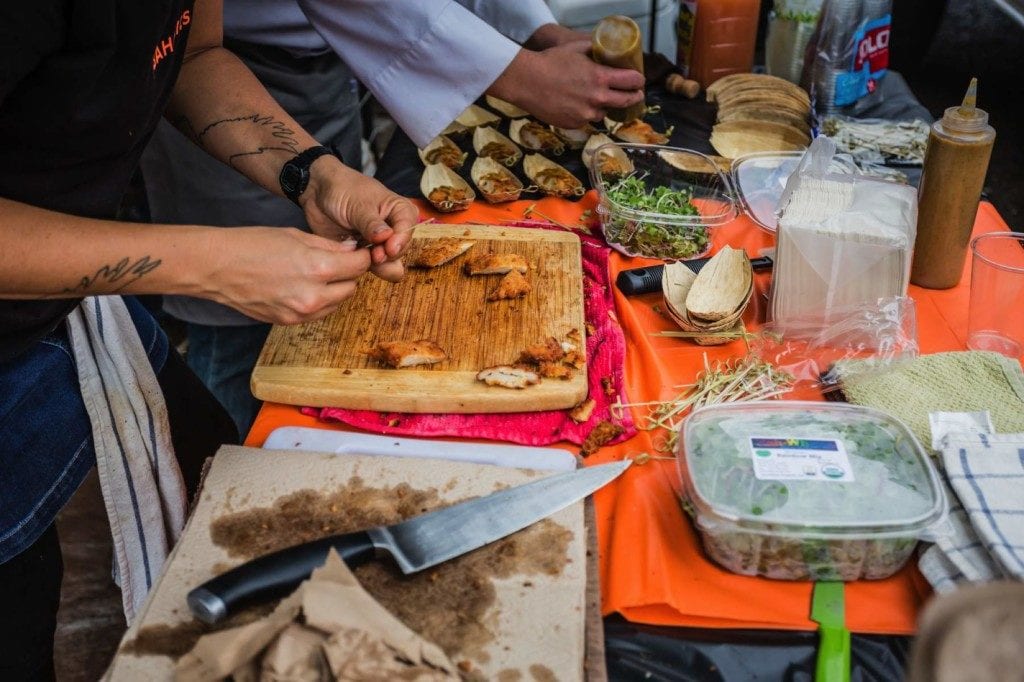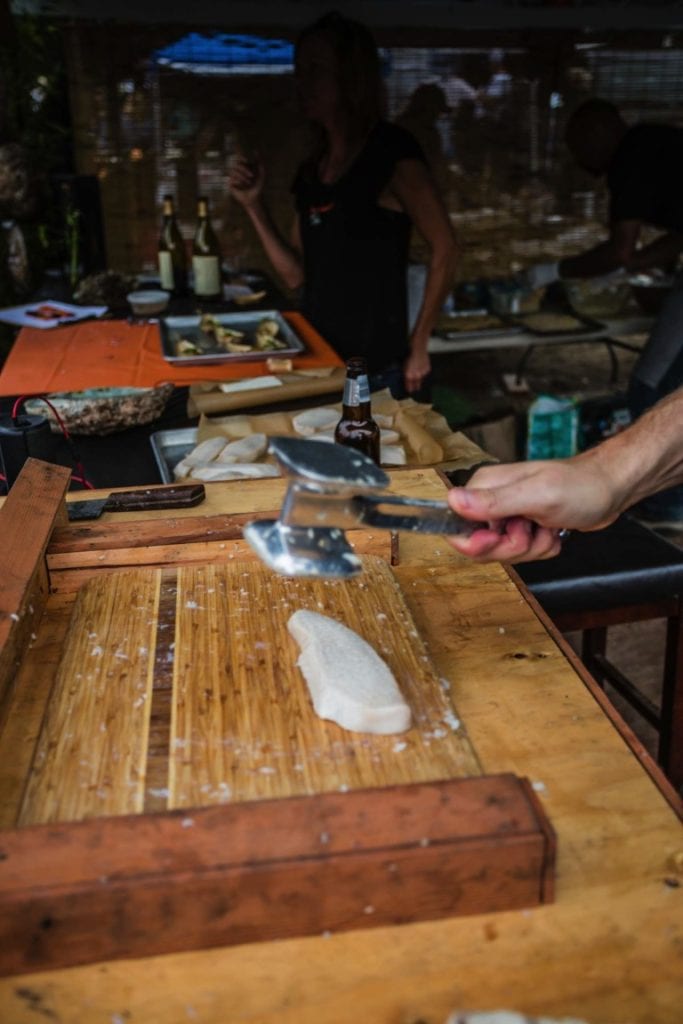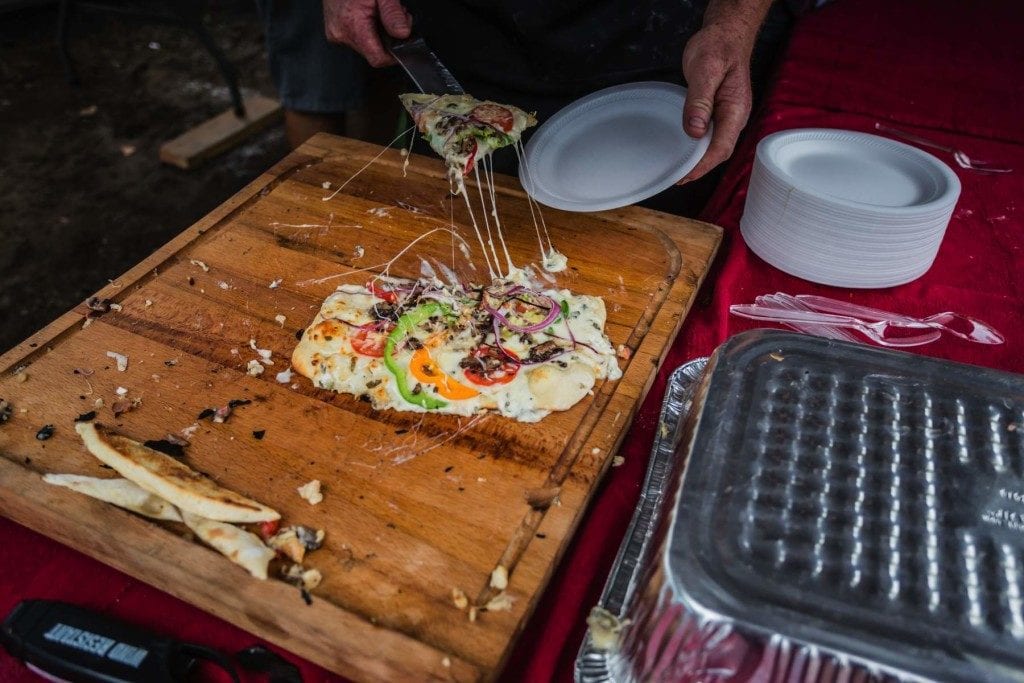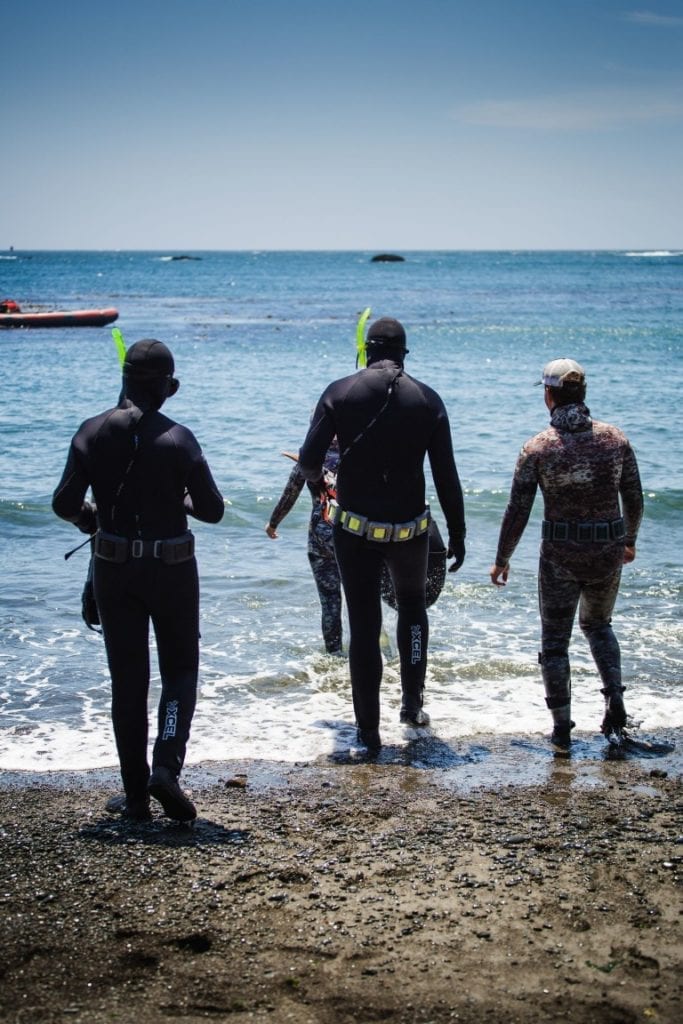ABALONE SEASON IS NOW CLOSED INDEFINITELY. THIS PAGE REMAINS AS A HISTORIC DOCUMENT, AND WE WILL UPDATE IT IF THE SITUATION CHANGES.
Abalone. It’s arguably the most sought after and romanticized delicacy in America – belonging, for those in the know, to the same rarified class of food as caviar, black truffles, and Kobe. Although farmed abalone does exist, most people who’ve had both will tell you there’s no comparison between it and wild. And with wild red abalone closed for commercial fishing – and commercial sale – that means for most people the only opportunity they’ll have to taste it is if they have a friend who dives, hunts it, and cooks it for them.
But good news! There are a couple of alternatives to be found if you’re willing to drive up to Mendocino. Every year in June the Little River Inn holds their Abalone Camp – a weekend exploration of abalone, where visitors (even first-timers!) can go out with a guide, hunt their own abalone, and learn how to prepare it. And in October the Mendocino Area Parks Association organizes the World Championship Abalone Cook-off and Festival, where local chefs dive for abalone and prepare it – and members of the public taste through a wide selection of different preparations, judging who the king (or queen) of the abalone cooks is.
So what is abalone? There are somewhere between 30 and 130 species worldwide (it’s a bit tricky to tell where one species ends and another begins). But for most people there’s only one food abalone worth talking about – and that’s the red (Haliotis rufescens). It’s basically a giant sea snail – not unlike conch, periwinkle, or whelk. But it’s absolutely delicious. And since it can reach up to a foot in length (seriously – the largest confirmed abalone caught was 12.34 inches!), it has plenty of tasty meat to eat. (And just in case you were wondering, there are actually seven species in California: red, white, green, pink, black, flat, and pinto).
So what does it taste like? Well, I’d say somewhere between a squid and a scallop – with a rich saltiness and butteriness built in. Most people bread and grill them, but we’re partial to a simpler preparation that really lets the abalone meat itself shine through. It’s a bigger delicacy in Japan and the rest of Asia than in the United States, but it’s starting to become a darling food of top chefs – who are using the (in our opinion, inferior) farmed variety. In Asia they also treat the ‘edge’ as a delicacy, although in the United States nearly all chefs dispose of it as a waste product.
Even if you’ve never tasted the meat, you’ve probably come across the abalone shell – either whole, hanging on a wall, or in shards as jewelry. Although the exterior is colored based on the abalone diet (in this case, red), the interior has an iridescent nacre that shifts between pink, red, green, purple, blue, and silver.
Oh, and if you’re wondering, it’s pronounced ab-uh-LOW-nee.
Changing Ecology
Humans have been eating red abalone about as far back as we can measure – there are middens in the Channel Islands dating back 7,500 years, and there’s good reason to believe their use as food dates back up to 12,000 years. But in recent decades their population has been threatened – in part by human fishing, and in part because the sea otter population has been steadily recovering (and sea otters enjoy a good abalone at least as much as people do!). In Southern California through much of the early 20thcentury wild abalone was fished commercially, and it devastated the populations (perhaps beyond recovery). In Northern California, thankfully, wild abalone was only fished on a wide-spread commercial scale for three years, and the population wasn’t quite as damaged.
So we’re lucky enough to (for now) still have personal sport fishing of abalone – albeit with strict guidelines to protect the remaining population. These rules shift year by year, in response to the constantly evolving needs of the fishery – stretches of coastline may be closed to personal fishing, minimum sizes may change, and daily and overall catch may be reduced. All in all, though, there’s hope that the red abalone population may continue to recover – so long as stewardship continues, poachers are prosecuted, and members of the community take seriously the care of this precious resource.
Last year, roughly 256,000 red abalone were legally taken by recreational divers on California’s north coast.
Rules of the Hunt
First of all, let’s talk about some of the basic regulations that restrict hunting abalone. These are important, and you should never stretch or bend the rules. Not only are they strictly enforced (and the California Department of Fish and Wildlife takes it very seriously), but they are in place to help protect the overall population.
Recreational abalone season for 2016 begins April 1st, runs through November (with no abalone hunting allowed during July), and is restricted to locations north of the Golden Gate Bridge in California. You cannot begin hunting abalone before 8am, to restrict the number of low-tide days people can rock pick (keep in mind, you can set out swimming or boating to your dive spot before 8am, but cannot begin diving until 8am). You can continue hunting until a half hour after sunset. Diving is restricted to non-equipment only (holding your breath), which for most purposes limits the maximum depth to roughly 30′. The annual limit is 18 abalone (only 9 can be from Sonoma/Marin). You can take three abalone in a day – and you can only have three abalone in your possession (that includes your refrigerator!) at any given time.
Your abalone have to be at least 7″ in length measured on the longest edge, and if you remove a legal-sized abalone you have to keep it as one of your catch (no discarding it for a bigger one later in your trip). Any undersized abalone you remove to measure have to be immediately replaced to the rock you pried them off of – though really it’s best to try very hard not to remove any undersized abalone, as you can damage them in the process of prying them off the rock. You can only remove an abalone with an abalone iron of less than 36″ or by hand, and no sharp edges are allowed.
Those are the basics, but it’s highly recommend you read the full regulations here to make sure you’re in compliance at all times – if you attend the Little River Inn’s Abalone Camp they’ll also walk you through all of the rules to help you stay legal.
Abalone Hunting
If you’re new to abalone hunting, we can’t stress enough that you go out with a guide or an experienced friend. It can be a bit overwhelming, keeping all of the rules in mind, finding a good field of abalone, free diving down, and prying them off gracefully and without damaging the abalone, all while holding your breath.
Even if you’re an experienced diver, we recommend always going with a friend, and skipping your dive if the ocean is rough – the coast of Mendocino can get very rough, very quickly, and there have been far too many tragedies over the years surrounding abalone diving. Stay safe, bring a buddy, and never dive beyond your comfort level.
Of course, you don’t have to dive for abalone. You’re free to ‘rock pick’ abalone – that means finding as low a tide as you can, and walking along the (often slippery) rocks, or wading in shallow water. Many people opt for this if they’re not entirely comfortable free diving, but keep in mind that the selection will be more limited above the low tide line, and you’ll have a harder time finding abalone above the legal size limit.
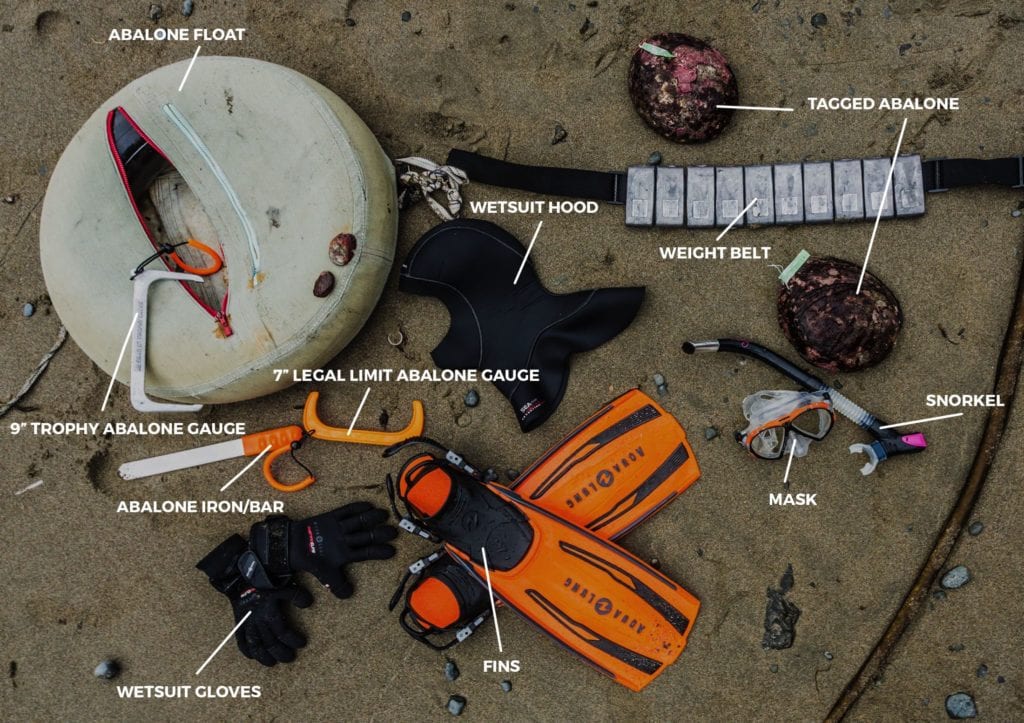
Get a full wetsuit that fits you – that means a hood, gloves, booties, and a full body suit. Mendocino County’s water is cold, even (especially) during the summer. Most people prefer a 4/3 wetsuit to keep you adequately warmed, while still allowing some mobility. You’ll want fins as well, and knowing how to use them will make your job a lot easier (at the Abalone Camp they’ll teach you how to use fins if you’ve never used them before). You’ll also need a snorkel, mask, abalone bar (to pry them off the rocks), abalone gauge (to measure the abalone and make sure it’s legal), a weight belt, and some sort of dive bag (you have to keep your abalone separate from those of other divers). Many dive shops will be able to fit you out with all the gear you need, and it is all included during the Abalone Camp.
You’ll want to dive in water that’s relatively deep – deeper than 15′ is a good rule of thumb. Although it might seem like diving in the shallows would be easier, in actuality the waves will be moving you around, making it difficult to remove abalone from the rocks (and if the waves get bigger they can pose a danger by throwing you against the rocks).
You’ll need to acquire some basic diving skills, either from attending the instructional portion of the Abalone Camp, or by taking lessons from your more-experienced friend who’s taking you out diving for abalone. Knowing how to clear your snorkel and breathe through it without sucking in water, how to clear your ears when diving, and how to safely navigate the water is crucial.
Once you’re out there – relax and have fun. One of the keys to a good dive is not rushing it. Take time to recover your oxygen each time you surface. Enjoy your time underwater while you scout out likely locations of big abalone. Maybe grab some urchins or rock crabs while you’re down there.
When you do find an abalone you’re confident is big enough, approach it calmly and carefully – there’s a reason we call it hunting abalone. Swirling the water around the abalone will scare it, and it will clamp down on to the rock, which may make it impossible to get it off. You’ll want to carefully and quickly slide your bar between the abalone and the rock, and pry it off – taking care not to slice into the flesh, in case it is undersized and you need to replace it. Swim back to the surface and measure it with your gauge. Remember: if it’s over 7″ in length you must keep it. If you accidentally pried off an undersized abalone (and please, please try to be certain of their size before prying them off!), immediately dive back down and replace it firmly on the rock where you found it.
You’ll probably find the biggest abalone hanging underneath large rocks, and in other out-of-the-way places. Remember, your maximum catch is only three abalone – so take your time really scouting out your dive location long before you pry anything off of the rocks. There’s no rush, and it’s peaceful down there. If you get lucky, maybe you’ll come up with a monster 10″ abalone before the day is over!
Abalone Preparation
Everyone has their own favorite way to prepare abalone – although in Northern California you’ll find most people believe in breading and frying it. Head to Hawaii and you’ll find an entirely different set of techniques. Go to Japan and you’ll find an even wider assortment. Like crab or scallops, people tend to have fairly strong feelings about what’s right and what’s wrong – but there are some basic rules of thumb.
First of all, you’ll need to get the abalone out of its shell. There’s basically one big muscle at the bottom of the abalone attaching it to the shell, so the trick is to pry something between the flesh and shell and use leverage to break that seal. Most people use a spatula or flat wooden spoon. Exert pressure against the shell, not the flesh, to try to keep everything intact.
Once you have the mass of flesh out of the shell, you’ll need to clean the guts. Use a sharp knife and cut away the dark viscera. You’ll probably want to just discard this – but in many cultures this part of the abalone is a prized delicacy, so if you’re feeling brave try saving them to fry or make into a soup. Then cut away the black ‘edge’ of the abalone – or if you want to retain absolutely as much meat as possible, scrub it away. Again, this can be saved as a delicacy or discarded. Most people then trim away the harder flesh (the ‘lips’) and the pointed end. You should now have a flesh-colored, clean piece of meat.
Now we’re in the realm of taste. But we find that the best way to proceed is to cut fairly thick ‘steaks’ out of the abalone – around a half inch thick. These steaks will then be pounded for some time to tenderize them – some people start with thinner slices (around a quarter inch) and pound them less, but that will leave you with thinner abalone that may break apart when you fry it. You may also choose to pound the abalone between plastic wrap, which will help prevent it from breaking apart as easily, though we find that isn’t as big an issue when starting with thicker steaks. We use a meat tenderizer, though again, some people prefer to just use the back of a spoon on thinner slices.
Once you have your tender abalone slices, you have a world of options. In Northern California most people fall back on simply breading their abalone and pan-frying it. You can also pan fry it without breading. Or sauté it. Or make a chowder. Or stir fry it. Or make it into burgers. The world is your oyster (or abalone). One thing to keep in mind: if you overcook it, you’ll end up with a rubbery dish, so watch your timing carefully – 30 seconds to a minute should be all most hot oil preparations will take.
Abalone Camp
Does this all sound great but a little bit intimidating? Don’t have a diving friend to lend you equipment, take you out, and teach you how to cook it? A few years ago you would have been out of luck – but now there’s an easy answer.
Every year in June the Little River Inn is running their Abalone Camp. It’s designed for everyone from absolute beginners to experienced divers who want to learn about abalone hunting and preparation. The world-renowned Triton X dive team acts as guides and supplies equipment. The Little River Inn provides rooms, amenities, and the cooking facilities.
Over the course of a weekend you’ll learn everything you need to know about diving for abalone, about the conservation efforts currently underway and how to support responsible stewardship, and you’ll go out diving two days with guides (the first day to get acquainted with the location, the second to hunt abalone). You’ll then be treated to a cooking demonstration, after being taught how to clean, cut, and pound abalone. You and your fellow divers will enjoy a feast of some of the abalone you caught prepared by a world-class chef (each guest donates one to the communal meal).
The Abalone Camp in 2016 runs from Sunday June 26 through Tuesday June 28, and prices start at $618 or $393 for a shared room (there are a whole slew of different room packages you can choose from). You can book with their front desk by calling 707.937.5942 and asking for the 2016 Ab Camp Package.
It’s a great way to get started in abalone diving, and to experience a once-in-a-lifetime delicacy from sea to table.
Abalone Cook-off
There’s another way to try wild abalone in Mendocino County – without even setting foot in the water. Every year the Mendocino Area Parks Association holds the World Championship Abalone Cook-off and Festival. Chefs from around the world prepare abalone they’ve caught themselves, and visitors judge them to choose the best of the best.
It’s an incredible experience. Not only is it a fun party – with music, wine tasting, raffles, and a craft fair – it’s a one-of-a-kind opportunity to sample a variety of abalone preparations all in one place. From Asian-inspired dishes to traditional fried abalone to raw ceviche style, there are abalone dishes here you’ve almost certainly never tasted.
In 2016 the Abalone Cook-off will be Saturday, October 8th. The Festival itself is free – that means you can come listen to music, taste wine, buy clam chowder, drink beer, and have a great time without paying a penny to get in the gate. In 2015 the cost to be a judge was $70 ($60 if you were a member of MAPA) – and that is the only way to sample the abalone (you can’t buy it at the booths, and the cooks are very strict with not giving out samples to non-judges). A judging ticket gets you ‘up to 10’ tastes – you’re part of a judging block and you get to taste at all of those booths. MAPA says up to 10 because cooks have to catch their own abalone, and if the weather conditions are bad or they just have a bad morning, some may have less abalone than others, and it’s possible some cooks will run out (in practice, though, it’s unlikely you won’t get to taste 9 or 10).
It’s difficult to explain just what a great experience this is. If you’ve already had abalone and know you like it, this is an amazing chance to see how different chefs prepare it. If you’ve never tried it, but you love food, this is really a one-of-a-kind experience. There just isn’t another place you can try wild abalone like this.
You can learn more here, and buy tickets when they go on sale.


